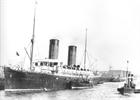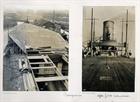On this day 17 April 1915
On this day 17 April 1915 Seaplane carrier HMS Campania launched
The British ship, HMS Campania, was the largest of a number of merchant ships converted to act as seaplane carriers during WW1. She was originally a record breaking Cunard liner, launching in 1893 and holding for a brief time the Blue Riband, but by 1914 her commercial life was over, and she was in the hands of the breakers. They had removed her deck fittings, but had not begun to work on the structure of the ship. On November 27, 1914 she was purchased by the Admiralty. After conversion, she was capable of high speed and and her hangars could stow 10 seaplanes; she had workshops to support the aircraft and a 120ft long slightly downward sloping flight deck. She spent several months conducting trials. Below is the report of the first take-off 6 August 1915.
Report by Wing Captain Oliver Schwann, commanding HMS Campania, to the Director of the Air Department, dated 8 August 1915.
As already reported to you by telegraph, Flight Lieutenant W L Welsh successfully flew a Sopwith Schneider Cup seaplane from the flying deck of this ship on the evening of the 6th instant. The following data with regard to the exploit are submitted:-
Weight of seaplane 1060lb + pilot 160lb + fuel 30lb + wheels 18lb = 1268lb. Speed of ship 17 knots steaming directly into wind of force 13 knots. Flying deck inclined 0 degrees 15 minutes towards the bows. The seaplane was placed on top of the forward seaplane hatch with the tail right up close against the fore bridge supports. The wheels of the seaplane were then 152ft from the bows. The engine was run at 1,050 revolutions and, with the tail float of the machine resting on the hatch, the seaplane was released at a given signal. As is usual with the 100hp Monosoupape Gnomes, the engine spluttered a little as the seaplane moved ahead; it soon picked up and on the whole pulled well.
The exact moment at which the tail lifted has not been definitely ascertained but it appears to be after running about 30ft. The elevator was kept hard down until the tail was up. It was then kept practically horizontal or slightly up for the whole run except just at the end when it was put considerably up.
The steering of the machine was fairly good. No rails of any description were fitted to the flight deck. The seaplane started with a little port helm in order to counteract the anticipated kick to the left on being released. The amount of helm given was rather too much and the aircraft went off to the starboard side slightly, just as it reached the flying deck. It was then brought back and went to about 5ft to the port side of the centre line. Port helm was given again and the machine was brought back to the centre line and crossed the bows exactly amidships. A proposal to keep the wheels of the seaplane running between rails or in grooved recesses is now finding favour amongst the pilots.
The seaplane left the deck, very gradually, thirty-nine feet from the bows or about thirty-two feet from a point where the flying deck becomes so narrow that one of the wheels of the seaplane would have gone off the edge had it not been flying.
No severe bumps or disturbance was felt by the pilot. He did not intentionally lift the machine into the air at all, but the machine lifted very rapidly just as it got ahead of the bows.
The time from the moment of releasing the seaplane to the moment it left the deck was six seconds.
The wheels were subsequently released by the pilot close to one of Campania's motor boats and were picked up.
The Commander-in-Chief, Grand Fleet, was pleased to signal his congratulations to Flight Lieutenant Welsh for this performance.
A great deal of discussion is now going on as to what shall be done to enable the seaplane to fly off the deck more easily and with a full load, as it will be seen that this aeroplane did not get off the deck any too easily.
Following further trials and experiments, HMS Campania's original design was subsequently modified in late 1915 early 1916 giving her a steeper, longer downward sloping platform. This refit saw her forward funnel replaced by two funnels side-by-side. The platform was extended to 200ft, starting between the new split funnel.




